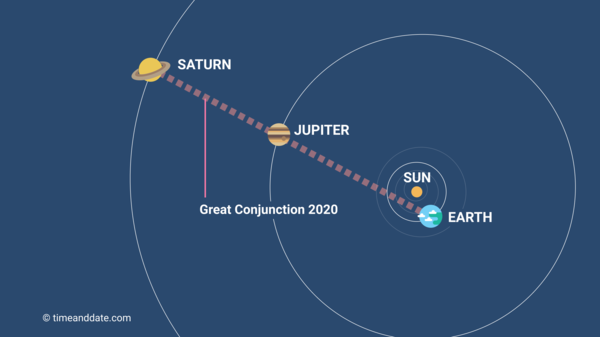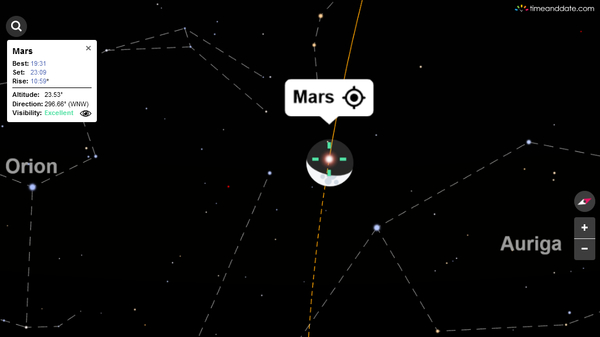What Is a Conjunction?
The sky is full of movement. When one astronomical object appears to pass close by another, it produces a conjunction.


Celestial bodies are separated by vast distances. However, when they form a straight line with the Earth in space, it looks to us as if they almost touch in the sky.
timeanddate.com
The Crescent Moon, Saturn & Venus align in January 2025
A Meeting in the Sky
A conjunction is when two astronomical objects appear close to each other in the sky. The bodies involved can be the Sun, the Moon, a planet, or a star.
Although the objects appear to be close, this is an illusion caused by perspective. During a conjunction, Earth forms an (almost) straight line with the two other bodies, so—from our viewpoint—it looks like they meet in the sky. In reality, however, the two bodies are separated by vast distances.
A Slow-Moving Spectacle
The Sun, the Moon, and the planets are always on the move. Technically speaking, therefore, a conjunction only lasts for an instant. (There are a number of ways to define a conjunction—one way is to say it is the moment of minimum separation between two objects as viewed from the Earth.)
However, for sky-watchers, the event plays out over a number of nights, as the two objects slide slowly past each other.
Some conjunctions are particularly impressive. For instance, the great conjunction of Jupiter and Saturn in December 2020 enchanted observers around the world.
Video: Jupiter and Saturn converging in the night sky in 2020. This simulation is for New York, USA, but the event could be seen all over the world.
timeanddate.com
On the other hand, conjunctions involving the Sun are impossible to observe because the Sun is so much brighter than anything else in the sky. The exceptions to this are eclipses and transits (see below).
How bright is the Sun on other planets?
Why Do Conjunctions Happen?
The solar system is the shape of a thin disk: the Earth, the Moon, and the planets orbit the Sun in roughly the same plane. Astronomers call this plane the ecliptic. Because of this alignment, the Sun, the Moon, and the five planets visible to the naked eye—Mercury, Venus, Mars, Jupiter, and Saturn—follow the same general path as they travel across Earth’s sky.
Night Sky Map: find objects in the sky
This is why the Sun, the Moon, and the planets sometimes meet in the sky. These meetings are conjunctions.
How Often Do Conjunctions Occur?
Conjunctions involving the Moon happen frequently. As it circles the Earth once a month, the Moon passes each of the planets in the sky, as well as the Sun (producing a New Moon).
The planets, on the other hand, move more slowly. A conjunction of Jupiter and Saturn, for example, only happens about once every 20 years.
Did You Know...?
Conjunctions have a rhythm! Find out more in Graham’s Sky & Telescope article about the 400-Year rhythm of Jupiter-Saturn conjunctions, co-authored with timeanddate.com CEO, Steffen Thorsen.

Conjunctions can involve any of the planets, as well as the Sun, the Moon, or a star. This photo shows a conjunction of Venus and Jupiter that took place low in the evening sky in June 2015. Venus is the brighter of the pair; Jupiter is just above it.
©iStockphoto.com/shaunl
Distance, brightness, and size of planets
Eclipses, Transits, and Occultations
Occasionally, a celestial object will pass directly in front of another. Depending on the objects involved, this produces an eclipse, a transit, or an occultation.
When the Moon passes in front of the Sun, the result is a solar eclipse (which is where the term ecliptic comes from). This occurs—somewhere in the world—every six months or so. The reason an eclipse doesn’t happen every month is that the Moon’s orbit is slightly tilted in relation to the ecliptic, and it normally passes above or below the Sun.
How often do solar eclipses occur?
Mercury and Venus can also pass in front of the Sun (although much more rarely than the Moon), producing a transit of Mercury or a transit of Venus.
If the Moon passes directly in front of a planet or star, it is called an occultation. For instance, on April 17, 2021, observers in South and Southeast Asia were able to see the Moon occult Mars.


An occultation of Mars by the Moon, as seen from Singapore on the evening of April 17, 2021. Although Mars shines brightly in this image from our Night Sky Map, it is, in fact, hidden behind the dark, unlit part of the Moon’s disk.
@timeanddate.com
Occultations can also be produced by planets. On October 1, 2044, Venus will occult Regulus (one of the brightest stars in the sky).
On rare occasions, planets can pass in front of each other. If one planet partially obscures another, the event is known as a transit. If one planet completely covers another, it is called an occultation. Venus will transit Jupiter on November 22, 2065. Alas, the two planets will be very close to the Sun, meaning this event will be extremely difficult to observe.